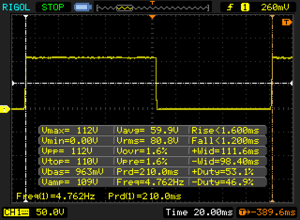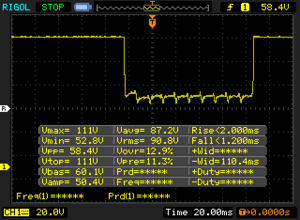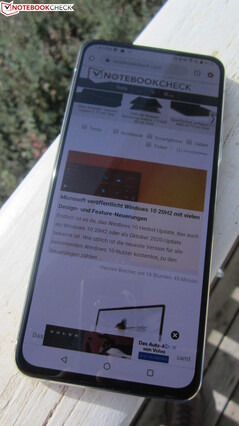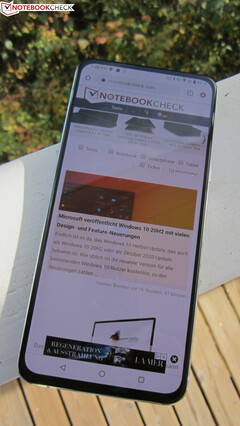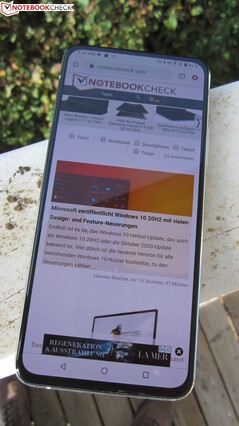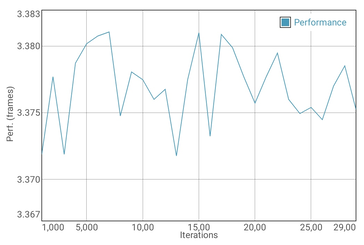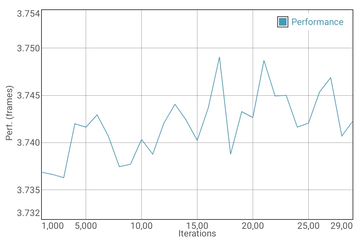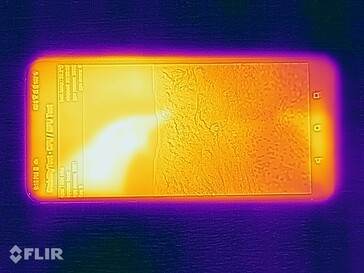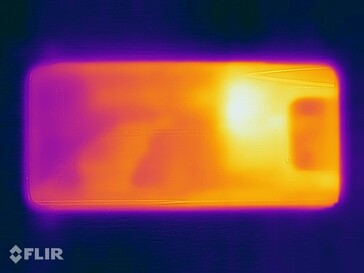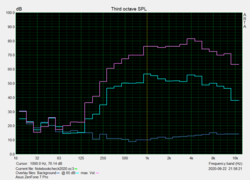Asus Zenfone 7 Pro (ZS671KS) Smartphone Review: Flip camera - take two
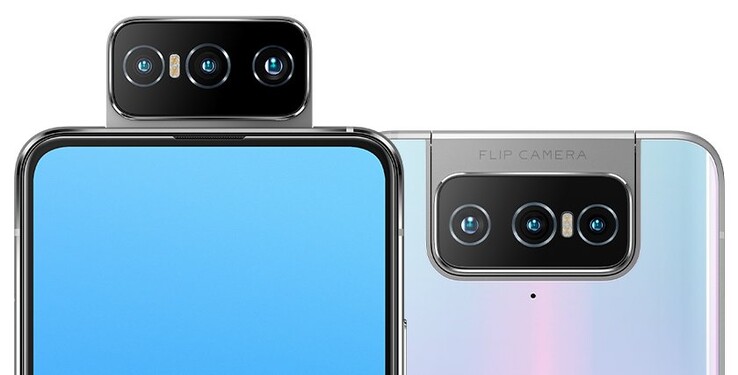
Asus has updated its budget flaship ZenFone 6. The ZenFone 7 offers premium features at a comparably affordable price. Unlike its predecessor, it is available in two versions: the ZenFone 7 ($940) and the ZenFone 7 Pro ($1100), which we will be testing today.
Both ZenFone 7 versions are the same except for a few details. The ZenFone 7 Pro is equipped with the fast Qualcomm SoC Snapdragon 865+, which Asus has also installed in its new gaming flagship ROG Phone 3. The ZenFone 7 on the other hand "only" runs on the Snapdragon 865, although this doesn't really limit it. Other differences: The ZenFone 7 Pro features just as much UFS 3.1 storage (256 GB) as the ZenFone 7 and also has an optical image stabilizer (OIS) on the main and telephoto lens.
The most distinctive features of the ZenFone 6 have been reused for the ZenFone 7 (Pro). Aside from the 5000-mAh battery, this includes a display without a camera notch – which is very rare these days – and the innovative flip camera with two lenses. Some new features are the OLED display, which replaces the IPS display of the ZenFone 6, the increased refresh rate of 90 Hz and 5G support.
Comparison devices
Rating | Date | Model | Weight | Drive | Size | Resolution | Price |
|---|---|---|---|---|---|---|---|
| 87 % v7 (old) | 10 / 2020 | Asus Zenfone 7 Pro ZS671KS SD 865+ (Plus), Adreno 650 | 235 g | 256 GB UFS 3.1 Flash | 6.67" | 2400x1080 | |
| 87.1 % v7 (old) | 09 / 2019 | Apple iPhone 11 Pro Max A13 Bionic, A13 Bionic GPU | 226 g | 64 GB SSD | 6.50" | 2688x1242 | |
| 89.4 % v7 (old) | 04 / 2020 | Huawei P40 Pro Kirin 990 5G, Mali-G76 MP16 | 209 g | 256 GB UFS 3.0 Flash | 6.58" | 2640x1200 | |
| 87.8 % v7 (old) | 10 / 2020 | OnePlus 8T SD 865, Adreno 650 | 188 g | 128 GB UFS 3.1 Flash | 6.55" | 2400x1080 | |
| 88.1 % v7 (old) | 10 / 2020 | Samsung Galaxy Note20 Exynos 990, Mali-G77 MP11 | 192 g | 256 GB UFS 3.1 Flash | 6.70" | 2400x1080 | |
| 88.2 % v7 (old) | 04 / 2020 | Xiaomi Mi 10 Pro SD 865, Adreno 650 | 208 g | 256 GB UFS 3.0 Flash | 6.67" | 2340x1080 |
Case - smart mix of metal and glass
The smart glass and metal look of the ZenFone 6 looks just as good on the new ZenFone. The front and back surfaces of the ZenFone 7 Pro are protected by a layer of Corning Gorilla Glass 6. The frame is made of aluminum and is milled from a single block. The high-quality material mix makes it almost impossible to warp or compress the smartphone and the device is comfortable to hold thanks to its rounded back cover. The ZenFone 7 Pro is not certified against dust and water.
Because the ZenFone 7 Pro has a 6.67-inch display instead of 6.4 inches, the dimensions of the phone have grown slightly as well. Only the thickness remains almost the same at 8.9 millimeters. The flip camera still stands out by around 2 mm when it its folded down.
The ZenFone 7 Pro, available in "Aurora Black" and "Pastel White" weighs a little more than its predecessor (235 grams vs 190 grams). Considering its size it doesn't feel particularly heavy. Its card slot can contain two Nano-SIM cards as well as a microSD card.
Connectivity - 256 GB UFS 3.1 storage are standard for the ZenFone 7 Pro
The large 256 GB UFS 3.1 storage in the ZenFone 7 Pro has around 236 GB available after the initial startup. Storage capacity can be expanded by up to 2 TB via a microSD card. At least in theory. At the moment, the largest microSD cards available are limited to 1 TB.
The USB port of the ZenFone 7 Pro only offers USB 2.0 speeds but supports USB OTG, which enables users to connect to peripherals and external storage devices. The phone also has a notification LED.
Software - Android 10, ZenUI 7 and hardly any bloatware
The ZenFone 7 Pro runs on Android 10. Asus also provides its own user interface ZenUI 7, which is only minimally different to standard Android. The Android security patches were dated September 1, 2020 at the time of testing (mid-October 2020). This means they are fairly up to date.
Asus has provided its budget flagship with a tidy system. Only the Google apps and a handful of its own system apps such as an audio recorder, a file manager and the tool Asus Data Transfer are preinstalled. While the device also comes with the third-party apps Facebook, Instagram and Netflix, these can all be uninstalled easily.
Communication and GPS - Fast WiFi and precise GPS on the Asus smartphone
The ZenFone 7 Pro communicates via WiFi 6 (WLAN 802.11ax) and is supported by 2x2 MIMO antenna technology. The device demonstrates attractive transfer rates in our test with the reference router Netgear Nighthawk AX12. Bluetooth 5.1 and NFC are also included.
The WiFi reception rate averages to around 856 MBit/s while it sends data at 693 MBit/s, which is still a decent speed. WiFi data transfer remains stable at all times. The low sending rate at the beginning does not impact overall performance.
The ZenFone 7 Pro uses all the main satellite network systems (GPS, Glonass, Galileo, BeiDou, QZSS and NavIC) for localization. This works quickly and precisely within three meters both indoors and out.
The smartphone also tracks our movements precisely. On our 12-km bike tour, the ZenFone 7 Pro managed to provide data that was almost as precise as that of the professional navigation system Garmin Edge 500 which we took along for a direct comparison. This means that the smartphone can provide apps with precise position data.
Telephony and Call Quality - Good 4G and 5G frequency coverage
The 19 LTE and 12 5G bands mean that the ZenFone 7 Pro covers a very wide range of frequencies and should have no issue establishing a connection in other countries. With its two SIM slots, the smartphone can maintain one 5G and one 4G or two 4G connections simultaneously.
Both SIM cards support VoLTE via 4G according to the user's manual. Although our provider also supports this function, we couldn't find any settings for it or VoWiFi in the phone menu. Presumably the manual is a little ahead of its time. In the past, Asus has retrofitted VoLTE and VoWiFi via a later update on some of its smartphones. Users of the ZenFone 7 Pro can hope for such an update.
The ZenFone 7 Pro offers good call quality. Our test calls to landline and mobile networks went well on both sides with noise cancelling successfully filtering out bothersome background noises. Voices also sound fairly clear and natural on speakerphone.
Cameras - Triple flip camera with adjustable opening angle
The figurehead of the Asus ZenFone 7 Pro is its flip camera. While the ZenFone 6 was limited to two lenses and a maximum of 48 MP, the main camera now offers 64 MP. The Sony IMX686 (ZenFone 6: Sony IMX586) works with an f/1.8 aperture and, unlike its predecessor, an optical image stabilizer (OIS).
The camera trio is completed by the 12-MP ultra-wide angle lens Sony IMX363 and the 8-MP telephoto lens Omnivision OV08A, equipped with 3x zoom and OIS. Video recordings in particular benefit from this setup. They turn out very steady and (much like the photos) are of good quality in good lighting.
The trick of the flip camera is that it can flip up on the press of a button, so that it is available for selfies with the same features of a full 64-MP resolution, auto focus and video recording at 8K and 30 fps. The ZenFone 7 Pro is really an ideal choice for selfie lovers.
The main camera takes good, vivid pictures in daylight, although the images can even appear slightly artificial due to the high sharpness. The main camera does less well in low lighting as it looses a lot of fine details. High-end competitors such as the Apple iPhone 11 Pro or the Huawei P40 Pro do a significantly better job here.
Image comparison
Choose a scene and navigate within the first image. One click changes the position on touchscreens. One click on the zoomed-in image opens the original in a new window. The first image shows the scaled photograph of the test device.
Tageslicht-Szene 1Tageslicht-Szene 2Weitwinkel5-facher ZoomLowlight-UmgebungWe took a closer look at camera quality in controlled lighting. In bad lighting (top color card) the ZenFone 7 Pro's colors are far from ideal. Fortunately, the situation turns around in good lighting (bottom color card) with very accurate colors and a sharp test chart.
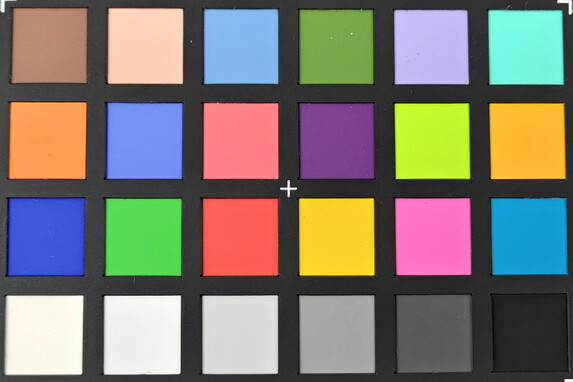

Accessories and Warranty - 30-Watt AC adapter and two protective cases included
Asus has included a modular 30-Watt AC adapter, a USB cable (Type C to Type C), a SIM tool, two protective cases made of plastic (one of them transparent) and a quick start guide as well as the warranty information in the ZenFone 7 Pro's box. You cna purchase offers various accessories including power banks, headphones, adapters and cables from the manufacturer's website.
The Asus ZenFone 7 has a 24-month warranty.
Input Devices & Handling - 90-Hz screen and fast authentication
As expected, the Qualcomm Snapdragon 865+ SoC combined with 8 GB of LPDDR5 RAM and the fast UFS 3.1 storage ensure the smooth performance of the ZenFone 7 Pro. This includes the reactive AMOLED touchscreen. Thanks to the refresh rate of 90 Hz, the ZenFone 7 Pro responds to inputs quickly and precisely.
The Asus smartphone can be unlocked via PIN and pattern or alternatively via capacitive fingerprint or face recognition. The fingerprint sensor is positioned on the power button and recognizes up to 5 fingerprints. It unlocks the smartphone almost immediately during our test. Authentication via 2D Face Unlock also works quickly. While this requires you to flip up the camera, this doesn't really slow down the process as the mechanism works very quickly.
Display - ZenFone 7 Pro with HDR+, 90 Hz and DC dimming
The 6.67-inch AMOLED display of the ZenFone 7 Pro has a high luminosity of around 690 nits and an even brightness distribution. The maximum luminosity increases to 993 nits when light and dark areas are distributed evenly (APL50). Deactivating the brightness sensor limits the maximum brightness to 490 nits. The minimum brightness of 2.27 nits ensures that the users' eyes are protected when using the AMOLED display in the dark.
Its resolution of 2.400 x 1.080 pixel means that the ZenFone 7 Pro can display content sharply. The device is in good company - all of today's high-end comparison devices offer at least the same level or resolution. The Huawei P40 Pro and Xiaomi Mi 10 Pro also have a refresh rate of 90 Hz while the OnePlus 8T even has 120 Hz.
While the Asus smartphone does use PWM to manage brightness, the flickering has a relatively high frequency of 186.6 - 384.6 Hz and should not be an issue for most users. The device also supports DC dimming.
| |||||||||||||||||||||||||
Brightness Distribution: 95 %
Center on Battery: 684 cd/m²
Contrast: ∞:1 (Black: 0 cd/m²)
ΔE ColorChecker Calman: 1.3 | ∀{0.5-29.43 Ø4.78}
ΔE Greyscale Calman: 1.9 | ∀{0.09-98 Ø5}
99.9% sRGB (Calman 2D)
Gamma: 2.29
CCT: 6475 K
| Asus Zenfone 7 Pro ZS671KS Super AMOLED, 2400x1080, 6.7" | Apple iPhone 11 Pro Max OLED, 2688x1242, 6.5" | Huawei P40 Pro OLED, 2640x1200, 6.6" | OnePlus 8T AMOLED, 2400x1080, 6.6" | Samsung Galaxy Note20 Super AMOLED Plus, 2400x1080, 6.7" | Xiaomi Mi 10 Pro Super AMOLED, 2340x1080, 6.7" | |
|---|---|---|---|---|---|---|
| Screen | -2% | -1% | 17% | -38% | 18% | |
| Brightness middle (cd/m²) | 684 | 790 15% | 584 -15% | 743 9% | 610 -11% | 753 10% |
| Brightness (cd/m²) | 690 | 790 14% | 576 -17% | 734 6% | 621 -10% | 762 10% |
| Brightness Distribution (%) | 95 | 97 2% | 95 0% | 91 -4% | 95 0% | 96 1% |
| Black Level * (cd/m²) | ||||||
| Colorchecker dE 2000 * | 1.3 | 1.4 -8% | 1.1 15% | 0.89 32% | 2.4 -85% | 0.9 31% |
| Colorchecker dE 2000 max. * | 2.5 | 3.4 -36% | 2.3 8% | 1.69 32% | 4.3 -72% | 1.6 36% |
| Greyscale dE 2000 * | 1.9 | 1.9 -0% | 1.8 5% | 1.4 26% | 2.8 -47% | 1.5 21% |
| Gamma | 2.29 96% | 2.23 99% | 2.16 102% | 2.199 100% | 2.09 105% | 2.24 98% |
| CCT | 6475 100% | 6466 101% | 6355 102% | 6423 101% | 6368 102% | 6415 101% |
* ... smaller is better
Screen Flickering / PWM (Pulse-Width Modulation)
| Screen flickering / PWM detected | 384.6 Hz | ≤ 99 % brightness setting | |
The display backlight flickers at 384.6 Hz (worst case, e.g., utilizing PWM) Flickering detected at a brightness setting of 99 % and below. There should be no flickering or PWM above this brightness setting. The frequency of 384.6 Hz is relatively high, so most users sensitive to PWM should not notice any flickering. However, there are reports that some users are still sensitive to PWM at 500 Hz and above, so be aware. In comparison: 53 % of all tested devices do not use PWM to dim the display. If PWM was detected, an average of 8091 (minimum: 5 - maximum: 343500) Hz was measured. | |||
Asus promises DeltaE values below 1 and claims that its smartphone display is suitable for professional use thanks to this high accuracy. Our test unit couldn't quite reach this mark in our test, but this isn't really an issue. If you choose the lower of the two standard color modes, the ZenFone 7 Pro stands out with DeltaE values below 2, which is still considered a particularly accurate color display. The color temperature, gamma and color balance are perfect.
In order to reach this color accuracy, the Asus has to use the smaller sRGB color space. The larger DCI P3 color space, which is selected when you choose the top "standard" image mode, has a significantly lower color accuracy.
Display Response Times
| ↔ Response Time Black to White | ||
|---|---|---|
| 2.8 ms ... rise ↗ and fall ↘ combined | ↗ 1.6 ms rise | |
| ↘ 1.2 ms fall | ||
| The screen shows very fast response rates in our tests and should be very well suited for fast-paced gaming. In comparison, all tested devices range from 0.1 (minimum) to 240 (maximum) ms. » 12 % of all devices are better. This means that the measured response time is better than the average of all tested devices (20.2 ms). | ||
| ↔ Response Time 50% Grey to 80% Grey | ||
| 3.2 ms ... rise ↗ and fall ↘ combined | ↗ 2 ms rise | |
| ↘ 1.2 ms fall | ||
| The screen shows very fast response rates in our tests and should be very well suited for fast-paced gaming. In comparison, all tested devices range from 0.165 (minimum) to 636 (maximum) ms. » 12 % of all devices are better. This means that the measured response time is better than the average of all tested devices (31.6 ms). | ||
Due to its immense brightness reserves, the AMOLED display can display readable content even under direct sunlight. The viewing angle stability is good as well. Display content is displayed brightly and accurately even at wide angles.
Performance - Over 600 000 points in AnTuTu v8
The ZenFone 7 Pro is equipped with the fastest SoC currently available from Qualcomm - the Snapdragon 865+. The octa-core processor is accompanied by 8 GB of LPDDR5 RAM and the high-end graphics chip Adreno 650.
Our test unit can beat all Android comparison devices and also manages to reach 600 000 points in the prestigious AnTuTu benchmark. Only the Apple iPhone 11 Pro with its Apple A13 Bionic SoC can beat this.
Surfing the web is not a particular challenge for the ZenFone 7 Pro. Our browser benchmarks result in the same pattern as before: First comes the Apple iPhone 11 Pro, then the ZenFone 7 Pro and the remaining Android competition. There was one slip however: The Asus refused to get along with the Speedometer 2.0 test and landed on last place in this test.
| Jetstream 2 - 2.0 Total Score | |
| Average of class Smartphone (23.8 - 387, n=149, last 2 years) | |
| Apple iPhone 11 Pro Max (Safari Mobile 13.1) | |
| Average Qualcomm Snapdragon 865+ (Plus) (69.8 - 75.5, n=4) | |
| Huawei P40 Pro (Huawei Browser 10.1) | |
| Asus Zenfone 7 Pro ZS671KS (Chrome 81.0.4044.138) | |
| OnePlus 8T (Chrome 86) | |
| Xiaomi Mi 10 Pro (Chrome 81) | |
| Samsung Galaxy Note20 (Samsung Browser 12.1) | |
| JetStream 1.1 - Total Score | |
| Apple iPhone 11 Pro Max (Safari Mobile 13.1) | |
| Average Qualcomm Snapdragon 865+ (Plus) (121.7 - 131.5, n=4) | |
| Asus Zenfone 7 Pro ZS671KS (Chrome 81.0.4044.138) | |
| OnePlus 8T (Chrome 86) | |
| Huawei P40 Pro (Huawei Browser 10.1) | |
| Xiaomi Mi 10 Pro (Chrome 81) | |
| Samsung Galaxy Note20 (Samsung Browser 12.1) | |
| Speedometer 2.0 - Result 2.0 | |
| Average of class Smartphone (15.2 - 643, n=122, last 2 years) | |
| Apple iPhone 11 Pro Max (Safari Mobile 13.1) | |
| Huawei P40 Pro (Huawei Browser 10.1) | |
| OnePlus 8T (Chome 86) | |
| Xiaomi Mi 10 Pro (Chrome 81) | |
| Samsung Galaxy Note20 (Samsung Browser 12.1) | |
| Average Qualcomm Snapdragon 865+ (Plus) (41.2 - 73.3, n=4) | |
| Asus Zenfone 7 Pro ZS671KS (Chrome 81.0.4044.138) | |
| WebXPRT 3 - Overall | |
| Apple iPhone 11 Pro Max (Safari Mobile 13.1) | |
| Average of class Smartphone (38 - 380, n=31, last 2 years) | |
| Asus Zenfone 7 Pro ZS671KS (Chrome 81.0.4044.138) | |
| Average Qualcomm Snapdragon 865+ (Plus) (114 - 126, n=4) | |
| OnePlus 8T (Chrome 86) | |
| Xiaomi Mi 10 Pro (Chrome 81) | |
| Samsung Galaxy Note20 (Samsung Browser 12.1) | |
| Huawei P40 Pro | |
| Octane V2 - Total Score | |
| Apple iPhone 11 Pro Max (Safari Mobile 13.1) | |
| Average of class Smartphone (2228 - 121337, n=197, last 2 years) | |
| Average Qualcomm Snapdragon 865+ (Plus) (25953 - 27360, n=4) | |
| Asus Zenfone 7 Pro ZS671KS | |
| Huawei P40 Pro (Huawei Browser 10.1) | |
| Xiaomi Mi 10 Pro (Chrome 81) | |
| Samsung Galaxy Note20 (Samsung Browser 12.1) | |
| OnePlus 8T (Chrome 86) | |
| Mozilla Kraken 1.1 - Total | |
| Samsung Galaxy Note20 (Samsung Browser 12.1) | |
| Xiaomi Mi 10 Pro (Chrome 81) | |
| Huawei P40 Pro (Huawei Browser 10.1) | |
| Average Qualcomm Snapdragon 865+ (Plus) (1854 - 1947, n=4) | |
| OnePlus 8T (Chrome 86) | |
| Asus Zenfone 7 Pro ZS671KS (Chrome 81.0.4044.138) | |
| Average of class Smartphone (257 - 28190, n=155, last 2 years) | |
| Apple iPhone 11 Pro Max (Safari Mobile 13.1) | |
* ... smaller is better
The UFS 3.1 storage device lets the ZenFone 7 Pro load and store content quickly. We used our 64-GB reference card Toshiba Exceria Pro M401 to measure microSD performance, which turned out to be only average. Then again, the other high-end smartphones aren't much faster either.
| Asus Zenfone 7 Pro ZS671KS | Huawei P40 Pro | OnePlus 8T | Samsung Galaxy Note20 | Xiaomi Mi 10 Pro | Average 256 GB UFS 3.1 Flash | Average of class Smartphone | |
|---|---|---|---|---|---|---|---|
| AndroBench 3-5 | -9% | -29% | -11% | -3% | 12% | 50% | |
| Sequential Read 256KB (MB/s) | 1713 | 1775 4% | 1659 -3% | 1683 -2% | 1739 2% | 1757 ? 3% | 2228 ? 30% |
| Sequential Write 256KB (MB/s) | 766 | 395.7 -48% | 728 -5% | 780 2% | 750 -2% | 1204 ? 57% | 1852 ? 142% |
| Random Read 4KB (MB/s) | 272.7 | 228.1 -16% | 132.6 -51% | 207.6 -24% | 264.9 -3% | 287 ? 5% | 296 ? 9% |
| Random Write 4KB (MB/s) | 284.9 | 271.8 -5% | 121.4 -57% | 233.8 -18% | 258.5 -9% | 318 ? 12% | 339 ? 19% |
| Sequential Read 256KB SDCard (MB/s) | 81.8 ? | 82.3 ? 1% | 75.9 ? -7% | ||||
| Sequential Write 256KB SDCard (MB/s) | 61.6 ? | 68.1 ? 11% | 61.9 ? 0% |
Games - Games run at up to 90 fps
The ZenFone 7 Pro is equipped with the Adreno 650, which currently is the fastest smartphone graphics unit available. This is good news for gamers. Current games are displayed very smoothly and can be played at up to 90 fps. We used the tool GameBench to measure framerates.
Emissions - No throttling under load despite high-end SoC
Temperature
The front and back of the ZenFone 7 Pro reach a maximum temperature of 37.4 °C, which is not particularly hot. The aluminum frame, on the other hand, can become uncomfortably warm when the smartphone is put under a lot of load. However, this is no longer noticeable if you put the smartphone in a protective case.
The ZenFone 7 Pro also has its core temperatures under control. The GFXBench battery test showed that the performance remained at the same level even after rendering the two test scenarios T-Rex and Manhattan 30 times. This means that there is no throttling.
(+) The maximum temperature on the upper side is 34.8 °C / 95 F, compared to the average of 35.2 °C / 95 F, ranging from 21.9 to 247 °C for the class Smartphone.
(+) The bottom heats up to a maximum of 37.4 °C / 99 F, compared to the average of 34 °C / 93 F
(+) In idle usage, the average temperature for the upper side is 30 °C / 86 F, compared to the device average of 32.9 °C / 91 F.
Speakers
The stereo speakers of the ZenFone 7 Pro are positioned to the right of the USB C port. They can reach a maximum volume of 88.5 dB(A) while still producing a clear sound. While bass tones are underrepresented, mids and highs are very linear.
The ZenFone 7 Pro does not provide an audio jack. Speakers and headphones can be connected wirelessly via Bluetooth 5.1, which also supports aptX Adaptive.
Asus Zenfone 7 Pro ZS671KS audio analysis
(+) | speakers can play relatively loud (88.5 dB)
Bass 100 - 315 Hz
(-) | nearly no bass - on average 31.9% lower than median
(±) | linearity of bass is average (11.6% delta to prev. frequency)
Mids 400 - 2000 Hz
(+) | balanced mids - only 4.1% away from median
(+) | mids are linear (3.7% delta to prev. frequency)
Highs 2 - 16 kHz
(±) | higher highs - on average 5.3% higher than median
(+) | highs are linear (4.2% delta to prev. frequency)
Overall 100 - 16.000 Hz
(±) | linearity of overall sound is average (19.8% difference to median)
Compared to same class
» 31% of all tested devices in this class were better, 8% similar, 61% worse
» The best had a delta of 11%, average was 35%, worst was 134%
Compared to all devices tested
» 50% of all tested devices were better, 7% similar, 43% worse
» The best had a delta of 4%, average was 24%, worst was 134%
Xiaomi Mi 10 Pro audio analysis
(+) | speakers can play relatively loud (84.5 dB)
Bass 100 - 315 Hz
(-) | nearly no bass - on average 16.1% lower than median
(±) | linearity of bass is average (13.6% delta to prev. frequency)
Mids 400 - 2000 Hz
(+) | balanced mids - only 3% away from median
(+) | mids are linear (3.3% delta to prev. frequency)
Highs 2 - 16 kHz
(±) | higher highs - on average 5.3% higher than median
(+) | highs are linear (4.9% delta to prev. frequency)
Overall 100 - 16.000 Hz
(±) | linearity of overall sound is average (15% difference to median)
Compared to same class
» 2% of all tested devices in this class were better, 2% similar, 96% worse
» The best had a delta of 11%, average was 35%, worst was 134%
Compared to all devices tested
» 20% of all tested devices were better, 4% similar, 76% worse
» The best had a delta of 4%, average was 24%, worst was 134%
Battery Life - Fast charging but not so good stamina
Power Consumption
Asus has equipped the ZenFone 7 Pro with a 5000-mAh battery that can be recharged at up to 30 Watt with the included AC adapter. This recharges the battery to 50 percent in about half an hour and to 100 percent in 90 minutes. The Asus does not support wireless charging.
In order to protect the battery, users can set a charging limit in the battery settings. On top of that, slow charging can also be activated. This limits the charging capacity to either 10 or 18 Watt.
The ZenFone 7 Pro has very average power consumption rates that are neither particularly high nor particularly low when it comes to idling or running under load.
| Off / Standby | |
| Idle | |
| Load |
|
Key:
min: | |
| Asus Zenfone 7 Pro ZS671KS 5000 mAh | Apple iPhone 11 Pro Max 3969 mAh | Huawei P40 Pro 4200 mAh | OnePlus 8T 4500 mAh | Samsung Galaxy Note20 4300 mAh | Xiaomi Mi 10 Pro 4500 mAh | Average Qualcomm Snapdragon 865+ (Plus) | Average of class Smartphone | |
|---|---|---|---|---|---|---|---|---|
| Power Consumption | -12% | 18% | -2% | 1% | 25% | -48% | -5% | |
| Idle Minimum * (Watt) | 0.63 | 0.92 -46% | 0.92 -46% | 1.1 -75% | 0.92 -46% | 0.61 3% | 1.3 ? -106% | 0.845 ? -34% |
| Idle Average * (Watt) | 2.06 | 2.9 -41% | 1.41 32% | 1.5 27% | 1.5 27% | 1.19 42% | 3 ? -46% | 1.44 ? 30% |
| Idle Maximum * (Watt) | 2.08 | 2.94 -41% | 1.47 29% | 1.7 18% | 1.54 26% | 1.23 41% | 3.19 ? -53% | 1.625 ? 22% |
| Load Average * (Watt) | 5.55 | 3.65 34% | 3.35 40% | 4.6 17% | 5.49 1% | 4.18 25% | 6.96 ? -25% | 7.01 ? -26% |
| Load Maximum * (Watt) | 9.71 | 6.18 36% | 6.37 34% | 9.4 3% | 9.99 -3% | 8.53 12% | 10.5 ? -8% | 11.3 ? -16% |
* ... smaller is better
Battery Life
Unfortunately, the immense capacity of its 5000-mAh battery does not translate into long battery life for the ZenFone 7 Pro. Although all comparison devices come with a (sometimes significantly) smaller battery, they all manage to beat the Asus smartphone in terms of battery life.
AWith a runtime of 11:17 hours the ZenFone 7 Pro delivers a decent performance in our simulated web browsing test, but is far from providing the incredible battery life Asus hints at. Our H.264 video test runs for 16:37 hours before the battery is empty. Again, this is a decent, but not particularly impressive result.
| Asus Zenfone 7 Pro ZS671KS 5000 mAh | Apple iPhone 11 Pro Max 3969 mAh | Huawei P40 Pro 4200 mAh | OnePlus 8T 4500 mAh | Samsung Galaxy Note20 4300 mAh | Xiaomi Mi 10 Pro 4500 mAh | |
|---|---|---|---|---|---|---|
| Battery runtime | 76% | 13% | 25% | 36% | 27% | |
| Reader / Idle (h) | 20.2 | 43.6 116% | 24.6 22% | 25.7 27% | 34.5 71% | 35.6 76% |
| H.264 (h) | 16.6 | 22.4 35% | 19 14% | 18.4 11% | 18.7 13% | 16.2 -2% |
| WiFi v1.3 (h) | 11.3 | 15.2 35% | 12.4 10% | 17.1 51% | 9.8 -13% | 14.4 27% |
| Load (h) | 3.1 | 6.8 119% | 3.3 6% | 3.4 10% | 5.4 74% | 3.3 6% |
Pros
Cons
Verdict - Very fast but no longer a bargain
The ZenFone 7 Pro is a worthy successor of the ZenFone 6 that has been improved in several areas. For example, it is now equipped with an AMOLED display with a diagonale of 6.67 inches and a 90-Hz refresh rate, a flip camera with a higher resolution and three lenses, 5G support and an even faster SoC, the Snapdragon 865+.
The Asus ZenFone 7 Pro impresses with its good connectivity and is one of the fastest Android smartphones available. The real budget flagship, however, is the ZenFone 7, which is available for another $100 less.
But even the ZenFone 7 Pro has some limitations. For example, it lacks an IP certification and wireless charging support. We also missed the VoLTE and VoWiFi telephony features, although Asus might be supplying these with a later update.
The ZenFone 6 was a real budget flagship. The ZenFone 7 Pro isn't quite as convincing in this role. At $1000, it isn't a particularly affordable smartphone, even for the high-end segment.
The ZenFone 7 is a much better fit for the budget label. The ZenFone 7 Pro's smaller brother costs around $100 less and is basically identical with our test unit apart from a few details. If you can make do with 128 GB rather than 156 GB of storage and a slightly slower Snapdragon 865 and you don't need an optical image stabilizer in the camera, then the ZenFone 7 might be your best bet. The OnePlus 8T also works as a good alternative to the ZenFone 7 Pro.
Asus Zenfone 7 Pro ZS671KS
- 08/31/2022 v7 (old)
Manuel Masiero




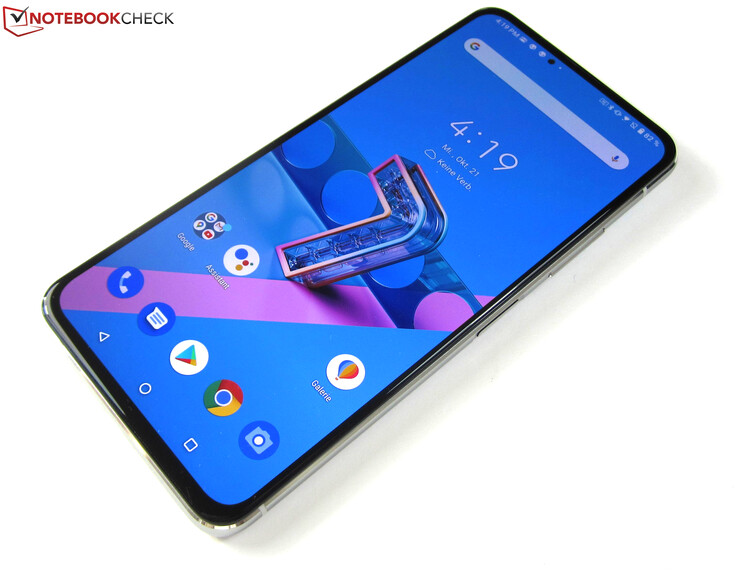




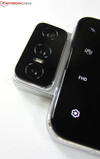
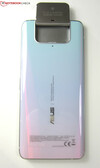
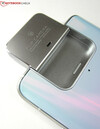


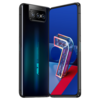









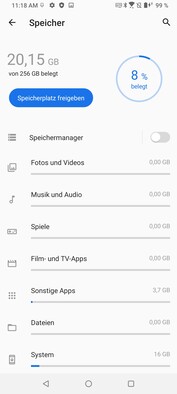
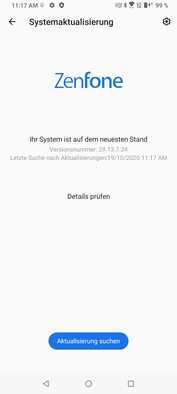
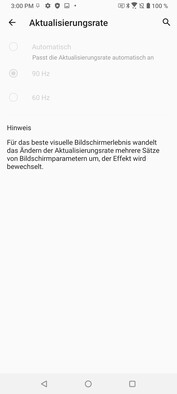
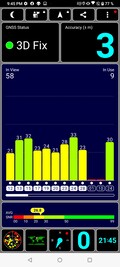
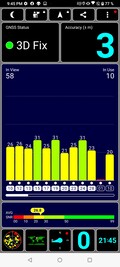
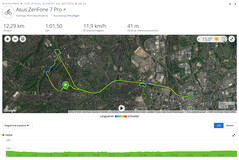
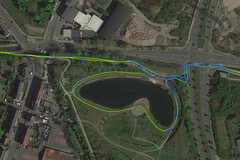
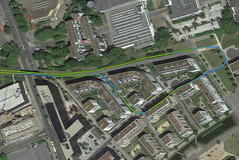
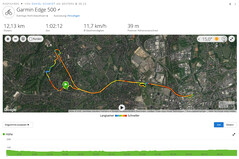
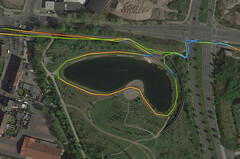
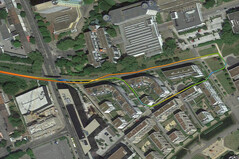




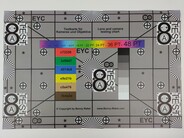





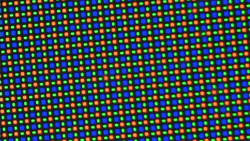
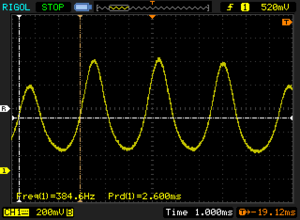
![Color accuracy (screen color standard [top], target color space P3)](fileadmin/_processed_/a/a/csm_CalMAN_Standard_ColorChecker_P3_25af5a628a.jpg)
![Color accuracy (screen color standard [bottom], target color space sRGB)](fileadmin/_processed_/6/9/csm_CalMAN_StandardUnten_ColorChecker_sRGB_01c4272adf.jpg)
![Color space (screen color standard [top], target color space P3)](fileadmin/_processed_/d/4/csm_CalMAN_Standard_Colorspace_P3_a7b003372b.jpg)
![Color space (screen color standard [bottom], target color space sRGB)](fileadmin/_processed_/c/c/csm_CalMAN_StandardUnten_Colorspace_sRGB_d2ba608774.jpg)
![Grayscales (screen color standard [top], target color space P3)](fileadmin/_processed_/c/d/csm_CalMAN_Standard_Grayscale_P3_07a044baa0.jpg)
![Grayscales (screen color standard [bottom], target color space sRGB)](fileadmin/_processed_/4/2/csm_CalMAN_StandardUnten_Grayscale_sRGB_4c9cd03c98.jpg)
![Saturation (screen color standard [top], target color space P3)](fileadmin/_processed_/c/4/csm_CalMAN_Standard_Saturation_P3_173b41382f.jpg)
![Saturation (screen color standard [bottom], target color space sRGB)](fileadmin/_processed_/e/4/csm_CalMAN_StandardUnten_Saturation_sRGB_f6ea89636e.jpg)
